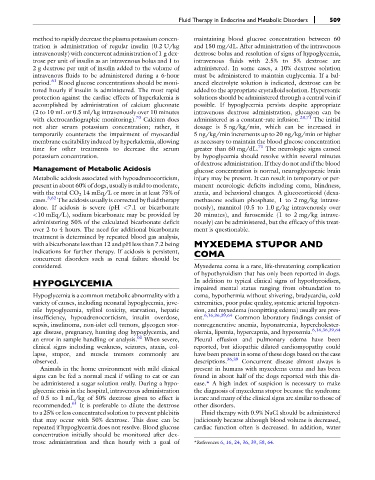Page 521 - Fluid, Electrolyte, and Acid-Base Disorders in Small Animal Practice
P. 521
Fluid Therapy in Endocrine and Metabolic Disorders 509
method to rapidly decrease the plasma potassium concen- maintaining blood glucose concentration between 60
tration is administration of regular insulin (0.2 U/kg and 150 mg/dL. After administration of the intravenous
intravenously) with concurrent administration of 1 g dex- dextrose bolus and resolution of signs of hypoglycemia,
trose per unit of insulin as an intravenous bolus and 1 to intravenous fluids with 2.5% to 5% dextrose are
2 g dextrose per unit of insulin added to the volume of administered. In some cases, a 10% dextrose solution
intravenous fluids to be administered during a 6-hour must be administered to maintain euglycemia. If a bal-
period. 61 Blood glucose concentrations should be moni- anced electrolyte solution is indicated, dextrose can be
tored hourly if insulin is administered. The most rapid added to the appropriate crystalloid solution. Hypertonic
protection against the cardiac effects of hyperkalemia is solutions should be administered through a central vein if
accomplished by administration of calcium gluconate possible. If hypoglycemia persists despite appropriate
(2 to 10 mL or 0.5 ml/kg intravenously over 10 minutes intravenous dextrose administration, glucagon can be
with electrocardiographic monitoring). 70 Calcium does administered as a constant-rate infusion. 28,71 The initial
not alter serum potassium concentration; rather, it dosage is 5 ng/kg/min, which can be increased in
temporarily counteracts the impairment of myocardial 5 ng/kg/min increments up to 20 ng/kg/min or higher
membrane excitability induced by hyperkalemia, allowing as necessary to maintain the blood glucose concentration
time for other treatments to decrease the serum greater than 60 mg/dL. 71 The neurologic signs caused
potassium concentration. by hypoglycemia should resolve within several minutes
of dextrose administration. If they do not and if the blood
Management of Metabolic Acidosis glucose concentration is normal, neuroglycopenic brain
Metabolic acidosis associated with hypoadrenocorticism, injury may be present. It can result in temporary or per-
present in about 60% of dogs, usually is mild to moderate, manent neurologic deficits including coma, blindness,
with the total CO 2 14 mEq/L or more in at least 75% of ataxia, and behavioral changes. A glucocorticoid (dexa-
cases. 3,62 The acidosis usually is corrected by fluid therapy methasone sodium phosphate, 1 to 2 mg/kg intrave-
alone. If acidosis is severe (pH <7.1 or bicarbonate nously), mannitol (0.5 to 1.0 g/kg intravenously over
<10 mEq/L), sodium bicarbonate may be provided by 20 minutes), and furosemide (1 to 2 mg/kg intrave-
administering 50% of the calculated bicarbonate deficit nously) can be administered, but the efficacy of this treat-
over 2 to 4 hours. The need for additional bicarbonate ment is questionable.
treatment is determined by repeated blood gas analysis,
with a bicarbonate less than 12 and pH less than 7.2 being MYXEDEMA STUPOR AND
indications for further therapy. If acidosis is persistent, COMA
concurrent disorders such as renal failure should be
considered. Myxedema coma is a rare, life-threatening complication
of hypothyroidism that has only been reported in dogs.
HYPOGLYCEMIA In addition to typical clinical signs of hypothyroidism,
impaired mental status ranging from obtundation to
Hypoglycemia is a common metabolic abnormality with a coma, hypothermia without shivering, bradycardia, cold
variety of causes, including neonatal hypoglycemia, juve- extremities, poor pulse quality, systemic arterial hypoten-
nile hypoglycemia, xylitol toxicity, starvation, hepatic sion, and myxedema (nonpitting edema) usually are pres-
insufficiency, hypoadrenocorticism, insulin overdose, ent. 6,16,36,39,64 Common laboratory findings consist of
sepsis, insulinoma, non-islet cell tumors, glycogen stor- nonregenerative anemia, hyponatremia, hypercholester-
age disease, pregnancy, hunting dog hypoglycemia, and olemia, lipemia, hypercapnia, and hypoxemia. 6,16,36,39,64
an error in sample handling or analysis. 61 When severe, Pleural effusion and pulmonary edema have been
clinical signs including weakness, seizures, ataxia, col- reported, but idiopathic dilated cardiomyopathy could
lapse, stupor, and muscle tremors commonly are have been present in some of these dogs based on the case
observed. descriptions. 36,39 Concurrent disease almost always is
Animals in the home environment with mild clinical present in humans with myxedema coma and has been
signs can be fed a normal meal if willing to eat or can found in about half of the dogs reported with this dis-
be administered a sugar solution orally. During a hypo- ease.* A high index of suspicion is necessary to make
glycemic crisis in the hospital, intravenous administration the diagnosis of myxedema stupor because the syndrome
of 0.5 to 1 mL/kg of 50% dextrose given to effect is is rare and many of the clinical signs are similar to those of
recommended. 61 It is preferable to dilute the dextrose other disorders.
to a 25% or less concentrated solution to prevent phlebitis Fluid therapy with 0.9% NaCl should be administered
that may occur with 50% dextrose. This dose can be judiciously because although blood volume is decreased,
repeated if hypoglycemia does not resolve. Blood glucose cardiac function often is decreased. In addition, water
concentration initially should be monitored after dex-
trose administration and then hourly with a goal of *References 6, 16, 24, 36, 39, 58, 64.

